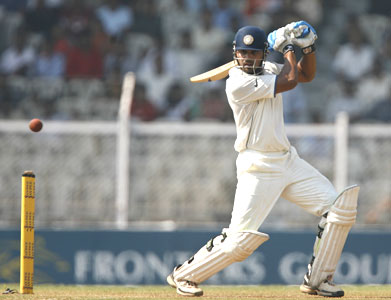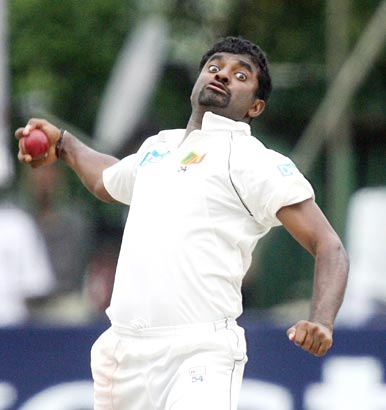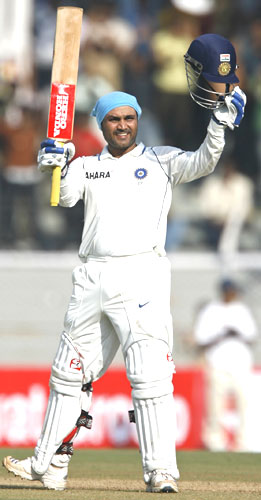 | « Back to article | Print this article |
In M Vijay, Sehwag revelled in the perfect accomplice for his style of batsmanship
When Virender Sehwag got to a typically rambunctious run-a-ball century (101 off 101), Murali Vijay was batting 81 (108 balls) at the other end.
That statistic defines the partnership and, more importantly, the self-belief of the Chennai youngster. It is a year and a month since Vijay played his first and thus far, only Test. He has spent those 13th months in the team's boot, as the spare tire waiting for a puncture.
Gautam Gambhir's affection for his sister gave Vijay the opportunity a dubious gift, since he would have known going in that Gambhir merely has to announce his availability to be picked. Yet he played with a freedom that was refreshing to watch, making the most of opportunity when it presented itself.
Sehwag's reaction when Vijay got to his 50 by dancing down to loft Murali for a six over long on said it all: the fist bump damn near crippled Vijay for life; the hug drove what little breath was left out of the youngster. Sehwag loves combative players as much as he hates overly defensive partners; in Vijay he revelled in the perfect accomplice for his patented brand of calculated mayhem and likely saw, in a youngster willing to take on the highest wicket taker in Tests, a player after his own heart.
In Kanpur, Gambhir had provided him the cover while he reined in his more destructive impulses early on, and Sehwag went on record to voice his appreciation. Here, Vijay with all the aplomb, if not a hundredth of Gambhir's experience performed the exact same function, stroking smoothly in the early overs while Sehwag was getting over his frets and setting himself for ritual butchery.
Besides those broad points, what impressed about Vijay was the quality of shot selection and execution. Vijay's driving through covers is classical (there was one bended knee effort of Welegedara that made you forget you were supposed to be working, and stand to applaud); he plays with felicity off his pads; and he is clearly aware of the importance of singles as a weapon of attack (between them, the two openers had 59 singles (Vijay 27) in course of the 221 run opening partnership, that also had 26 fours and six sixes.)
Sehwag saw the introduction of Herath as the start of a batting power play
So impressive was the youngster that it seemed almost tragic when he missed a sweep at a Herath flipper on middle stump, and with it the century that he so fully deserved.
As he walked off the field, the question that occurred was: what now? What can the team do with this kid? Clearly it would be folly to split the VS-GG combination. But as clearly, you want to blood promising young talent at that precise moment when ability and confidence are in perfect lock-step. Facilitating that is the conundrum the management will now have to crack before the fizz goes off and he becomes another careworn journeyman.
About Sehwag, what is there to say that hasn't been said before? When he bats at his best the man defies superlatives. Today was one such.
Having paid ritual obeisance to the trope of "getting his eye in", Sehwag saw the advent of spin, in the form of Herath, as the start of a prolonged batting power play (and the use of One-day idiom is justified during one frenzied ten over spell between lunch and tea, the scoring rate accelerated through the 6 run-per-over mark without check, and hit an almost obscene 7.3 over the course of ten overs).
There was one period of a real contest between Muralitharan and Sehwag
But it was one passage of play between Muralitharan and Sehwag that would get top billing in any highlights package I curate. It began in the 4th over; Murali had been hit for boundaries in each of his first three overs, and seemed to be working on some tactic involving the space near Sehwag's off stump. The batsman on that occasion waited an eternity, then played a cut so impossibly late it almost defied geometry.
Cue the 5th over. Murali increased his length; Sehwag skipped down the track and contemptuously wafted him high over long on. You saw the bowler pause, wonder what there was left to try and then he sent down an arm ball angling across the stumps towards leg. A ploy, perhaps, to have Sehwag stranded if he tried another little dance? No matter Sehwag danced out again; by way of increasing the degree of difficulty, he opted to simultaneously run around the line of the ball, get it on his off side, and then used wrists and timing to pick the four to a ball that at this point was already outside leg stump line between the bowler and mid off.
What is a bowler even one with 788 Test wickets bowling on a responsive track to do?
As always when Sehwag is front and centre, adjectives fail and you are forced to lean on the crutch of statistics to describe both his innings and his impact on the side's fortunes: 92 runs in the session before lunch in just 18 overs (Sehwag 53); 168 runs in 27 overs between lunch and tea (Sehwag 98); at that point (shortly before tea, Sehwag developed problems with his back, so the second interval of the day seems a good point to assess his stats at their best he had taken 42 runs off 38 balls from Murali and an astonishing 50 off just 32 balls from the highly rated Herath, preferred for the second time ahead of one-time mystery spinner Ajantha Mendis.
Sehwag scores those big runs at a pace that sets it up for his team
Most importantly, even at tea time India had already raced to 260 off just 45 overs brilliant in an ODI context but in Tests, of incalculable value. Today is just the second day. 270 overs remain to be played in this Test. And with 13 more overs left to play in the final session, India had already after taking out the two remaining Lankan wickets in the morning knocked off the Lankan first innings score of 393 and gone into the lead, with three full days of play remaining.
The problem with appraising Viru in terms of stats is that the stats are so startling you begin hunting for the very adjectives you ran out of in the first place. Consider this: the man has six double hundreds, more than any other Indian batsman ever. And of those six, five are in the list of the fastest doubles of all time; in fact, he owns three of the top four slots, and is the only batsman to have more than one entry in that list.
Here's why: his progression from the 180s to the double ton, in the 57th over of the innings bowled by Nuwan Kulasekhara, was dot, 4, 4, 4, 2, 4. With every other batsman currently active, you talk of the nervous nineties with Viru, as someone pointed out to me on Twitter, it is the hapless bowlers who get nervous when the man approaches some landmark. With every other batsman - including the great Sachin Tendulkar - the rival captain brings the field in to add pressure; with Viru, they send the fielders out on the fence and he pierces or clears them anyway.
The point though is not so much his propensity to score big; the real key to Sehwag is that he scores those big runs at a pace that sets it up for his team, even as he creates a slipstream for his colleagues to coast along in.
No one noticed Dravid's 50
Somewhere in the middle of all this, Rahul Dravid batting in the form of his life got another 50, but no one noticed (When the 200 run partnership for the second wicket the second successive double century stand of the Indian innings came up, Dravid had made 53; Viru contributed 146).
No one notices you, when Sehwag is going nuts at the other end in fact, that is precisely why, at the end of a day of Virender Sehwag, you still remember and acknowledge the little gem played by Murali Vijay at the top of the order. To be able, years later, to say to whoever will listen that he almost matched Viru Sehwag, batting at his incandescent best, stroke for stroke is given to few; Vijay is one of the select band that can use that story to pay for quite a few dinners.
The final session, truncated by three overs, was when Sehwag repeatedly showed signs of a bad back; in the final ten overs of that session the run rate slipped to a pedestrian at least by the standards of what had gone before 4.3.
And yet, it produced 183 runs in 34 overs, and saw India not just overhaul Lanka's first innings total in under a day, but actually go 50 runs into the lead. (On another note: Sehwag ended the day 16 shy of a triple century; 16 shy of becoming only the second batsman, after the Don, to score 300 in a day. He probably doesn't regret the missing three overs or the missed record; those of us watching haven't stopped cursing, though).
'I only hit the bad balls'
At a broader level, what the Indian response underscores is the criminal folly of the Lankan approach to their own first innings. Well though Harbhajan in particular, and the Indians in general, bowled for the most part, 393 is under-achievement of a very high order on this track, by this Lankan line-up, and even more so when one batsman gets a hundred and another narrowly misses a ton.
One final snapshot of Sehwag's dominance/Sri Lanka's helplessness on the day: this player versus player chart. When was the last time you've seen a bowling attack dominated to such an extent by one player, that every one of the front line bowlers is going at 100 runs or better strike rate?
"I only hit the bad balls," Sehwag said at the end of it all. In any one else, it would be considered arrogance, a gratuitous piling on of insult to injury. Somehow, when Sehwag says it, you tend to nod along in agreement he is, after all, the one contemporary batsman for whom any ball that leaves the bowler's hand is by his yardstick a bad ball.





